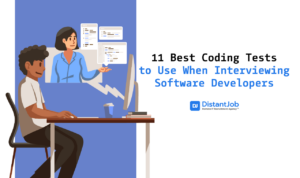In Product Development, there are three distinct roles, often confused: Product Manager, Product Owner, and Scrum Master. They have different focuses on the what, why, and how of a product’s creation, particularly within the Agile philosophy and the Scrum framework.
The Product Manager is the strategic visionary and is responsible for the product’s overall long-term success, market viability, and business value. The Product Owner is the product value maximizer, representing the voice of the customer and stakeholders to the development team. The Scrum Master is the servant-leader and process coach for the developer team.
However, since business and Scrum glossaries require a deeper understanding, these roles often overlap in day-to-day company affairs. Therefore, I’m providing you with a guide on how to hire and fulfill these roles.
But, before defining these roles, it will be useful to understand how they came to be.
How Product Management Came To Be
The origin of the Product Manager role can be traced back to the early 20th century, specifically to a memo written in 1931 by a young executive at Procter & Gamble (P&G).
Neil H. McElroy, a junior executive (who would later become President and U.S. Secretary of Defense), wrote a famous 800-word memo.
He argued for the need for dedicated “Brand Men” (which eventually evolved into Brand Managers, and in the future, would become Product Managers) who would be solely responsible for a specific brand of product.
Brand Managers or Brand Men had the following responsibilities:
- Tracking sales and performance.
- Developing advertising and promotional plans.
- Experimenting with packaging and marketing strategy.
- Keeping close tabs on the customer and the market.
In short, Brand Men used to ensure both marketing and branding strategies for a product.
At that time, the concept was revolutionary. It shifted focus from generic company sales to the success of an individual product (like a business owner), to a “Brand Man”, the first internal advocate for a product and its customer.
Product Managers in Tech
McElroy later advised Bill Hewlett and David Packard, the founders of Hewlett-Packard (HP). Inspired by the “Brand Man” concept, HP adapted it, creating a more formal role named “Product Manager”. The Product Manager served as an internal customer advocate, working directly with engineers, marking a key transition of the concept into a technology-focused organization.
Companies like Intuit (founded by Scott Cook, a former P&G “Brand Man”) and later Microsoft began to apply these product management principles to their software products.
Microsoft initially had a “Program Manager” role, but the need for a non-engineer “translator” between the customer, the business, and the engineers solidified the modern Product Manager position.
The Agile Manifesto and Scrum Framework
The creation of the Agile Manifesto in 2001 and the rise of frameworks like Scrum (which created the specific roles of the Product Owner and Scrum Master) further cemented the importance of the Product Manager in the iterative, fast-paced world of digital product development.
While Scrum doesn’t include a Product Manager role, businesses often choose to split the Product Owner into different job positions. Companies usually have a Product Manager role for more strategic reasons (writing Epics, defining Vision & Strategy, engaging in Market Research, and aligning with Stakeholders), and a Product Owner role to perform a more tactical role (manage the Product Backlog, writing User Stories, clarifying the Product Vision and Goals with the Developer Team, and inspecting the product Increment at the end of each sprint).
Again, both roles are envisioned by Scrum as a job only for Product Owners, but the reality in many companies is that these responsibilities are split.
What is a Product Manager?
A Product Manager is responsible for creating the Product Vision, elaborating the Product Roadmap, and aligning the Product Strategy with the needs of Internal and External Stakeholders.
Product Managers’ scope spans the entire product lifecycle (from conception to sunset). The PM’s role exists if there is a product, regardless of whether the team uses Scrum or not.
Product Manager Core Responsibilities
The Product Manager’s core focus is on the “what” and “why” of the product. In other words, Product Manager tasks involve everything from strategy, market, customers, and business value that is related to the product.
- Understand the Market where the Product is
- Understand the Client and User’s needs in depth
- Deliver Value to the Client/User
- Deliver Value to the Business
- Develop the Product Strategy
- Create the Product Roadmap
- Taking Data-Driven Decisions
What is a Product Owner?
A Product Owner is responsible for maximizing the value of the work of the Developers. In other words, the Product Owner aligns the developers’ work with the Product Strategy. In Scrum, the Product Owner also encapsulates all the previously mentioned Product Manager’s responsibilities. This last bit of info is crucial if you plan to earn a Scrum Certification: Scrum doesn’t have a Product Manager and doesn’t compare Product Owners with them.
The scope of a Product Owner (considering there is a Product Manager in the company) is inward-facing, focused on the execution of the product strategy within the development team and the short-term delivery cycle (Sprints). In some companies, especially in Pure Scrum ones, the PM and PO roles may be combined.
Product Owner Core Responsibilities
Product Owners have a more tactical approach. They are the professionals responsible for the Product Backlog. They also engage in stakeholder management to extract the maximum value from their needs to create a problem-solving Product with the Developers.
- Create, Manage, and Prioritize the Product Backlog
- Writing Epics, Features, User Stories, and Acceptance Criteria
- Developing the Product Vision
- Promote Product Backlog Transparency
- Ensure Developers understand Product Backlog Items to turn them into Sprint Backlog Items and Tasks
- Accept or Reject the Product Increment
- Represent the Stakeholders to the Developers
- Decide on a New Release of a Product
What is a Scrum Master?
Scrum Masters focus on the Scrum framework, process, team dynamics, and removing impediments. They observe if the Scrum Team follows the Scrum framework by the book. A Scrum Master is also responsible for helping the team perform at its best.
You might have noticed that we have seldom discussed Scrum Masters so far. The reason is that Scrum Masters have vastly different roles than their Product counterparts. Scrum Masters don’t have a scope on the Product; their focus is on the developer team and the company’s adoption of the Scrum framework.
In fact, you could say that Scrum Masters are much more like Agile Coaches than Product Owners or Product Managers.
Scrum Master Core Responsibilities
The Scrum Master’s core focus is on the Scrum Team (Developer Team and Product Owner) and the process of delivering work effectively. They focus purely on the “how” the work is being done, rather than the Product itself.
- Teaching the team and organization about Scrum and Agile principles.
- Facilitating Scrum events (like daily stand-ups, sprint planning, and retrospectives) to ensure they are productive and kept within the time limits.
- Identifying and removing obstacles (blockers/impediments) that prevent the developer team from achieving their Sprint Goal.
- Shielding the development team from external distractions and pressure.
- Assist the Product Owner by coaching them into new ways to prioritize the Product Backlog.
Product Manager vs. Scrum Master vs. Product Owner: A Comparison
The three roles (Product Manager, Product Owner, and Scrum Master) are distinct, with different focuses on the what, why, and how of a product’s creation, particularly within the Agile and Scrum frameworks. Below is a breakdown of their primary focuses and what questions they answer with their job.
| Role | Primary Focus | Key Question |
| Product Manager (PM) | Product Strategy, Market, Business Value | What is the most valuable product to build next, and why? |
| Product Owner (PO) | Product Backlog, Development Priorities | What work should the developer team do next? |
| Scrum Master (SM) | Scrum Process, Team Performance, Impediments | How can the team work most effectively? |
Conclusion
The Product Manager (PM) is the strategic visionary, defining the product’s long-term vision, strategy, and market viability. The Product Owner (PO) maximizes value, acting as the customer’s voice, managing the Product Backlog, and guiding sprint development. The Scrum Master (SM) is the servant-leader, maintaining the Scrum framework, optimizing team performance, and removing impediments.
While Scrum often combines all product responsibilities under the PO, many companies split strategic duties to a PM and tactical execution to a PO. Understanding these distinctions (strategic vs. tactical, product vs. process) is crucial. A PO can have PM responsibilities, but merging PO and SM roles is not advised as it overloads the position and harms product development. Clearly defining each role’s unique responsibilities ensures both market value and efficient delivery.





